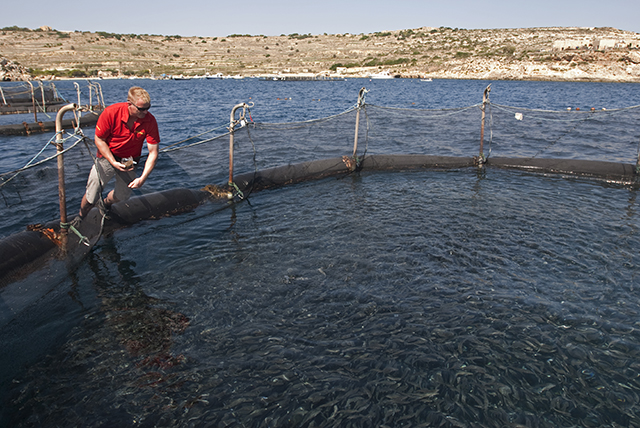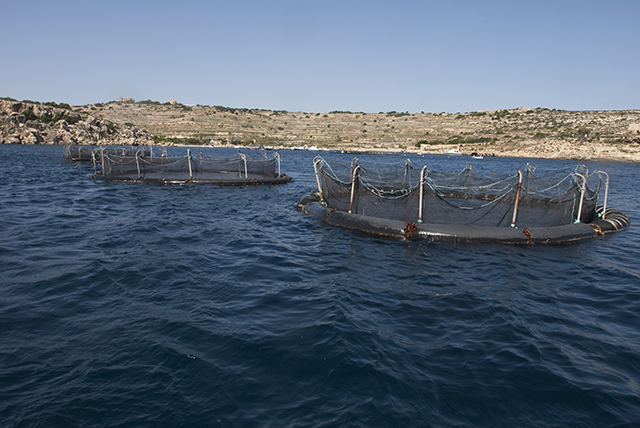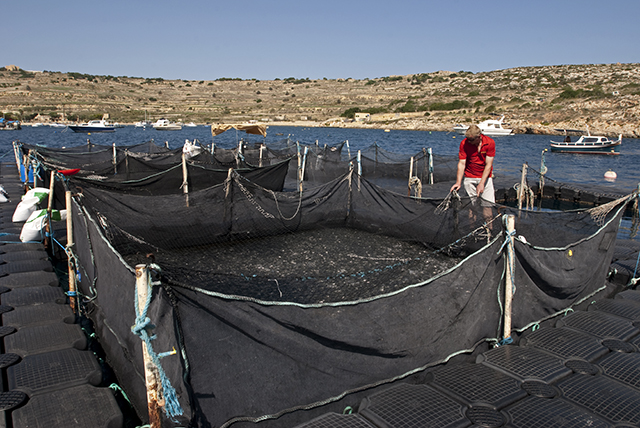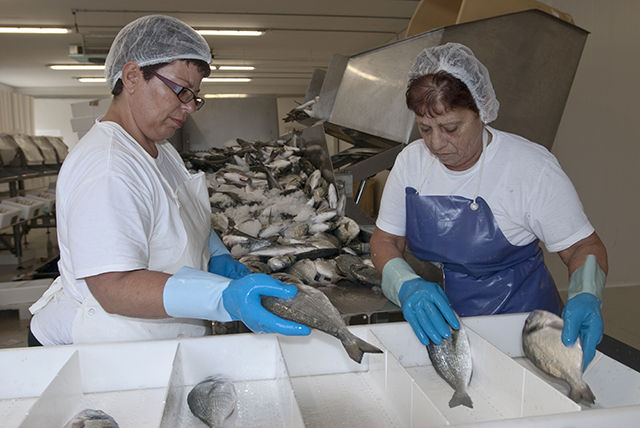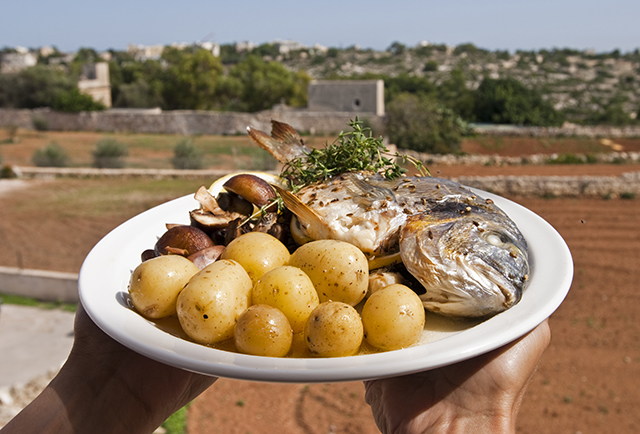Marine Life & Conservation
Aqua Farming: Fish For Thought
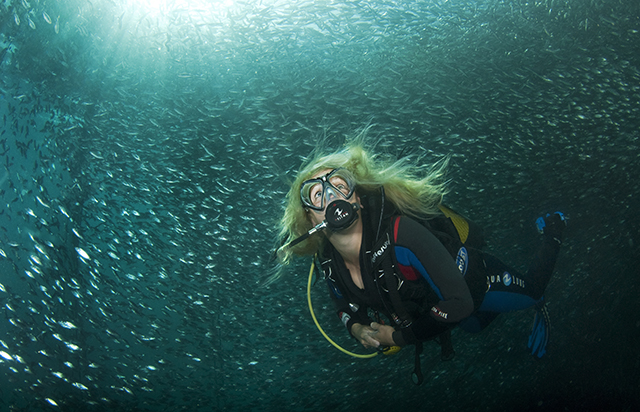
I would love to turn back the clocks and see the underwater world through Jacques Cousteau’s eyes. What an enviable experience – sailing the oceans, exploring pristine reefs thriving with marine life. But alas this is 2015, and as a globe-trotting scuba diver-come-photographer I am acutely aware of the problems facing our planet. Fish provide us with a vital food source but natural stocks are dwindling fast, in some cases so fast that a number of species including tuna are already on the IUCN critically endangered list. I can understand this is a complex situation, especially when there are mouths to feed and livelihoods at stake. Aqua farming may well be a viable solution.
In the quest to learn more I met up with Jes Brinch-Iverson, marine biologist and production manager for Pisciculture Marine De Malte (P2M) Limited. Jes, who has been associated with the company for the past 20 years, agreed to talk to me about the whole ‘farming’ process from its fingerling beginnings right through to serving up on a plate. The Maltese climate (water temp between 14-28 degrees) is ideal for cultivating sea bass (Dicentrarchus labrax), gilt-head sea bream (Sparus aurata) and meagre (Argyrosomus regius). Jes said they are also considering farming amberjacks (Seriola dumerili) sometime in the future.
In all P2M have 19 storage pens at St Pauls Bay and another 5 at Mellieha Bay. Jes said it’s difficult to get permits, especially for the inshore sites. Although the demand for fish farming is increasing there are strict regulations in place dictating depth limitations, environmental issues and proximity to tourism. P2M doesn’t receive any financial help from the Maltese government. Jes said “we do get some European funding for research into new products and improving quality”.
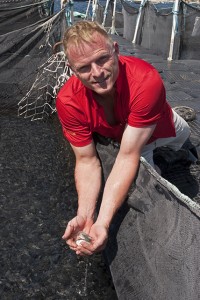 We hopped aboard one of P2M’s work boats and sped across to a cluster of small rectangular shaped pens located just a few hundred metres from the coastline. Jes wanted to show me a new batch of sea bream that had just arrived. The fingerlings or juveniles are supplied by companies from Spain, Italy and France. They are transported in trucks or put on cargo ships in large tanks. Oxygen is pumped into the water and the temperature reduced. This slows down the metabolism of the fish. A standard shipment is around 150,000 fingerlings. During the course of the journey there is about a 1% mortality rate.
We hopped aboard one of P2M’s work boats and sped across to a cluster of small rectangular shaped pens located just a few hundred metres from the coastline. Jes wanted to show me a new batch of sea bream that had just arrived. The fingerlings or juveniles are supplied by companies from Spain, Italy and France. They are transported in trucks or put on cargo ships in large tanks. Oxygen is pumped into the water and the temperature reduced. This slows down the metabolism of the fish. A standard shipment is around 150,000 fingerlings. During the course of the journey there is about a 1% mortality rate.
Jes scooped up a handful of the silvery sea bream fingerlings. He said “only the best quality fish are selected”. The fingerlings are around 100 days old when they arrive at the farm. Each little fish was roughly the size of my little finger and weighed approx 2g. Growth is related to feed and water temperature. Normally the fish are kept inside the holding pens for around 12 – 16 months before harvesting.
The floating pens basically comprise of a large doughnut shaped rubber float with an encompassing net like structure attached below. I watched Jes feeding the hungry hoard. The water surface was literally boiling with activity. The fish are fed twice a day. The fish meal is a mixture of soya, fish oil and vegetable. Proportionately it’s around 50 percent soya. The difference in taste from farmed and naturally wild fish is not significant and the texture is still the same. Jes said “we use high quality feed”. They regularly monitor the health of the fish. Jes said “problems with diseases are very rare. We don’t use any chemicals in the process”. There is also a team of scuba divers on hand to check the nets for holes and do routine maintenance/cleaning tasks. After a particularly bad storm in March 2012 they lost around 8% of the total stock from damaged pens. The local residents had an absolute field day catching all the fish and taking them home for a free bumper supper.
I wanted to try and get some underwater pictures of the farmed fish, so Jes suggested jumping into a 400 cu metre pen which was about 5 metres in diameter and 5 metres deep. The pen was populated with around 100,000 sea bass of sizes between 30 – 40g, which were roughly the length of my hand. Just to make my pictures a little more interesting I invited along local scuba diver Trudy Kerr. This would also add some perspective of size and scale. Both Trudy and Jes were regulars at Maltaqua dive centre based at St Pauls Bay.
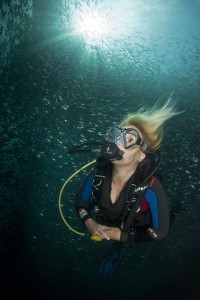
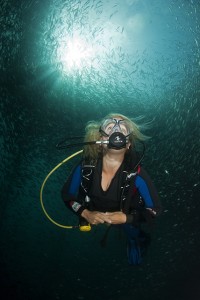 Just before entering the water we encountered a disastrous show stopper of a problem. Trudy’s semi-dry suit zip had stuck open. Unfortunately the zip in question was located right by Trudy’s cleavage. Trudy asked if we should abort the dive. I looked at Jes and he looked back at me. In about 3 micro seconds we made a joint executive decision to soldier on despite this major setback. So the sea bass ended up getting slightly more of an eyeful than expected. No wonder why they were flying around the pen in a complete frenzy! I really enjoyed being inside the pen surrounded by so many fish. I spent more than 45 minutes taking pictures of the swirling shoal. If I have one complaint to make, the fish could have been a tad bigger. Otherwise the visibility wasn’t too bad, there wasn’t too much detritus (fish poo) floating about and the lighting was okay. Trudy’s zip had by that point miraculously repaired itself.
Just before entering the water we encountered a disastrous show stopper of a problem. Trudy’s semi-dry suit zip had stuck open. Unfortunately the zip in question was located right by Trudy’s cleavage. Trudy asked if we should abort the dive. I looked at Jes and he looked back at me. In about 3 micro seconds we made a joint executive decision to soldier on despite this major setback. So the sea bass ended up getting slightly more of an eyeful than expected. No wonder why they were flying around the pen in a complete frenzy! I really enjoyed being inside the pen surrounded by so many fish. I spent more than 45 minutes taking pictures of the swirling shoal. If I have one complaint to make, the fish could have been a tad bigger. Otherwise the visibility wasn’t too bad, there wasn’t too much detritus (fish poo) floating about and the lighting was okay. Trudy’s zip had by that point miraculously repaired itself.
I had noticed quite a few local fishermen dangling rods close to the holding pens but couldn’t quite fathom out why, unless of course some of the fish managed to escaped from time to time. I heard Trudy shouting through her regulator and pointing outside the pen. I followed her line of sight and saw a giant trevally shaped predatory fish circling us. It was absolutely massive (1.5 metres long) and made me wonder what else might be out there beyond the mesh. Now that really was a scary thought… especially with the tuna pens being so close…
When we were safely back on board Jes took us over to one of the offshore pens full of larger sea bass. Jes said the 3,000 cu metre enclosure was around 15 metres in diameter and 12 metres deep. But the visibility was not so good inside this pen and the skittish fish were not so easy to photograph. We found 100’s of sea hares lying on the bottom which kept Trudy occupied for ages. Sea hares are herbivores so there must have been some kind of algae or plant life growing inside the pens that they liked to eat; or was it the fish poo? After 25 frustrating backscatter filled minutes I gave up taking photographs. I noticed there was a handful of dead fish bobbing about on the surface. Jes said this was the normal fall out rate. I’m not sure what had killed them and should have asked the question.
Before returning to the jetty Jes showed me the special harvesting boat. It works just like a giant vacuum cleaner sucking up the fish and passing them through a fast freeze unit. The cold shock instantly kills the fish. Any delay will affect the quality. They are then transferred to the nearby packing and processing plant. P2M had recently moved to new purpose built premises which also included a storage facility and office space. The company is privately owned and presently employs 51 people. Jes took me on a tour around the new plant. They were in the middle of processing a batch of sea bream. I watched the bream being unloaded and sorted onto a conveyor belt. The fish are rinsed, packaged up into boxes (at around 7kg a box) and transferred to ice trucks ready for delivery. I was impressed. The entire process took no more than 45 minutes.
The fish are not gutted and filleted, they are left whole. Jes said that the ideal ‘portion’ size for consumers weighs between 350 and 450g. On the open market prices are around 4 to 5 euro per kg. There are presently 6 fish farms in Malta exporting around 2,000 tons of cultivated fish each year of which a large percentage is shipped to supermarket chains in Italy. Delivery times from the holding pens to the local Maltese restaurants can be just a few hours. International deliveries usually take up to 24 hours. Jes said the fish have a 12-day shelf life.
I had learnt that Aqua farming doesn’t come cheap and there are many costs to consider. P2M do make a profit but fish are deemed an expensive commodity and demand is not so high. Jes said “the supermarkets dictate the prices and make most of the money”. Malta is planning to expand the aqua farming industry over the coming years. In my mind this is great news. More farmed fish means less fish taken from the sea which gives me a better chance of getting some half decent photographs.
Just to round off my day Jes handed me a sea bream sample for taste testing. I had never eaten sea bream before so was really looking forward to checking it out. The fish didn’t take very long to prepare or cook, especially as I wasn’t cooking it! I thought the roasted sea bream had quite a delicate texture and most of the flavour seemed to come from the herbs and the lemon. There were a few bones to contend with, but what did I expect – this was a fish! I would definitely eat it again and a bottle of chilled Gavi is the perfect accompaniment.
What are your views on aqua farming? Let us know in the comments section below.
Marine Life & Conservation
Paul Watson Released as Denmark Blocks Japan’s Extradition Bid

Renowned anti-whaling activist Paul Watson has been released from custody in Greenland after spending five months in detention. Denmark’s Justice Ministry rejected Japan’s request for his extradition, citing insufficient guarantees that his time already served in custody would be credited against any potential sentence.
The 74-year-old Canadian-American was arrested on July 21 in Nuuk, Greenland’s capital, when his ship docked to refuel. His arrest was based on a 2012 Japanese warrant related to a 2010 encounter in Antarctic waters. Japan alleged Watson obstructed operations and caused damage to a whaling research ship during efforts to disrupt illegal whaling. Watson has consistently denied these claims, maintaining his commitment to marine conservation.
Denmark, which oversees extradition matters for Greenland, concluded that while the legal conditions for extradition were met, the lack of assurances from Japan regarding time-served credit made extradition untenable.
In a video shared by his foundation, Watson expressed gratitude and relief, saying, “After five months, it’s good to be out… and good to know they’re not sending me to Japan.” He added that the most difficult part of his time in custody was being separated from his two young sons.
Watson is a pioneering figure in marine conservation, known for founding the Captain Paul Watson Foundation in 2022 after decades of activism with the Sea Shepherd Conservation Society. His bold efforts to defend marine life have earned him widespread support, including from celebrities and conservationists. His work has also been featured in the acclaimed reality TV series Whale Wars.
Watson’s lawyer, Jonas Christoffersen, praised the decision, stating, “We are happy and relieved that Paul Watson is now free.” He added that Watson is eager to reunite with his family and continue his vital work.
The arrest occurred while Watson’s vessel, the M/Y John Paul DeJoria, was en route to the North Pacific with a team of 26 volunteers to intercept a Japanese whaling ship. His foundation described the arrest as politically motivated and emphasized that Watson’s actions were focused on ending illegal whaling practices.
Japan resumed commercial whaling in 2019 after leaving the International Whaling Commission, asserting that whale meat is a cultural tradition. Conservationists, however, continue to challenge these practices, highlighting their impact on marine ecosystems.
Despite the challenges, Watson remains steadfast in his mission to protect marine life and bring attention to whaling practices. His dedication to ocean conservation has made him a globally respected advocate for the environment.
Marine Life & Conservation
12 Days of Zero-Waste Fish-mas

This holiday period, the Marine Conservation Society, the UK’s leading ocean membership charity, invites you to make some simple changes to eating fish this Christmas to help our seas.
Dr Kenneth Bodles, Head of Fisheries and Aquaculture at the Marine Conservation Society, said, “During the festive season, our consumption increases, but so does waste. Sustainability isn’t just about where food comes from – it’s also about how you use it. By reducing waste and making the most out of your seafood, you’re not only taking steps to be more ocean-friendly, but can also help to cut costs during what is often one of the most expensive times of the year”.
The Marine Conservation Society has compiled twelve tips on how to consume seafood sustainably with zero-waste this Christmas:
Buy whole fish instead of fillets
Instead of fillets, consider buying whole fish such as salmon, hake, or lemon sole. By adopting a “nose to tail” approach with cooking, whole-baked fish not only feeds a crowd, but also helps to minimise waste and maximise sustainability by using up every part of the animal, including bones, skin, and fat.
Make fish stock
Leftover fish bones or shells can be put to good use by boiling them to make a nourishing fish stock or bisque. This can be frozen and preserved for later use and makes for a flavourful base in a soup.
Make your own fish pâté
Avoid waste by turning leftover fish, such as smoked mackerel or salmon, into a delicious pâté by blending with cream cheese and lemon. Perfect when paired with crackers.
The sustainability of salmon and mackerel varies depending on where and how it is caught or farmed. For more information on green-rated options, check the charity’s Good Fish Guide.
Buy frozen
By purchasing seafood that is frozen or vacuum-packed, this helps to reduce waste by extending the shelf life of your food.
Fish pie
If you’re wondering what to do with leftover cooked fish, why not opt for a classic fish pie with mashed potatoes, leeks, and a cheesy sauce? A sure crowd pleaser on Boxing Day.
Use the head
Don’t forget the fish head! The meat is incredibly tender and flavourful. The charity recommends a cod’s head curry or recreating Fallow’s renowned cod’s head in siracha butter.
By stretching your ingredients further, not only is this a more sustainable way to enjoy seafood, but also cost-effective by repurposing leftovers and cooking creatively.
Boxing Day brunch
Mix leftover kippers or smoked salmon with scrambled eggs for a tasty, zero-waste, Boxing Day brunch.
For best choice, make sure you buy kippers, or herring, from the North Sea and the North Irish Sea.
Zero-waste storage
A top tip from the Marine Conservation Society to avoid waste is freezing fish offcuts to save for future use.
Crisp up the skin
Even leftover fish skin can be turned into a quick savoury snack by crisping it up in an air fryer with a little olive oil and salt.
Anchovies two ways
Leftover anchovies can either be blended with butter to make a delicious anchovy butter or tossed into pasta for a hit of umami flavour.
The charity recommends opting for anchovies caught in the Bay of Biscay for best choice.
Fishcakes
For an easy, zero-waste meal, leftover seafood trimmings can be mixed with mash and fried in breadcrumbs to make fishcakes.
Pickled mussels
Try pickling mussels in 1:1 vinegar and water, with a dash of sugar for a sustainable, zero-waste snack that can be enjoyed well beyond the festive season.
Mussels farmed in the UK are a seafood superhero. Grown using low-impact methods and harvested by hand, they get all the food they need from the sea around them. This makes them one of the most sustainable, ocean-friendly, and cost-effective seafood options.
Players of People’s Postcode Lottery have raised £6.6M towards the Marine Conservation Society’s vital work in making seafood more sustainable.
Laura Chow, Head of Charities at People’s Postcode Lottery, said: “Fish is a festive favourite for many, but making sustainable choices when it comes to how we buy and eat seafood makes all the difference for our ocean. Support from players of People’s Postcode Lottery has helped the Marine Conservation Society further its sustainable seafood work, so that we can all enjoy healthier, better protected seas.”
The Marine Conservation Society encourages you to make sustainable seafood choices a year-round habit, not just for Christmas. To check how sustainable the seafood on your plate is, you can visit the charity’s Good Fish Guide. The Guide helps consumers and businesses identify the most sustainable seafood using a simple traffic light system, based on where and how species are caught or farmed. Green is the best choice, amber means improvements are needed, and red indicates fish to avoid buying.
Zero-waste gift idea
Why not embrace a zero-waste Christmas by gifting a membership to support marine conservation? It’s a meaningful, low-waste gift that helps protect our ocean for generations to come. Memberships start from as little as £5 a month – the price of a sandwich and drink from your local coffee shop.
Find the latest sustainable seafood advice for wild-caught and farmed seafood on the Good Fish Guide, downloadable to your phone from www.mcsuk.org/goodfishguide.
-

 News2 months ago
News2 months agoIconic SS United States to become the World’s Largest Artificial Reef
-

 News3 months ago
News3 months agoBook Review – 52 Assignments: Underwater Photography
-

 Gear News3 months ago
Gear News3 months agoDYNAMICNORD – New German diving brand enters the British market
-

 News3 months ago
News3 months agoExploring Cenote El Pit: A Diver’s Dream
-

 Gear News3 months ago
Gear News3 months agoTry BARE drysuits (and maybe even win one!) this Friday with Sea & Sea at North West Dive Fest
-

 Marine Life & Conservation3 months ago
Marine Life & Conservation3 months agoBook Review: Coral Triangle Cameos
-

 Blogs2 months ago
Blogs2 months agoDive the Egyptian Red Sea this Autumn with Regaldive
-

 News3 months ago
News3 months ago2024 Ocean Art Underwater Photo Competition Announced


